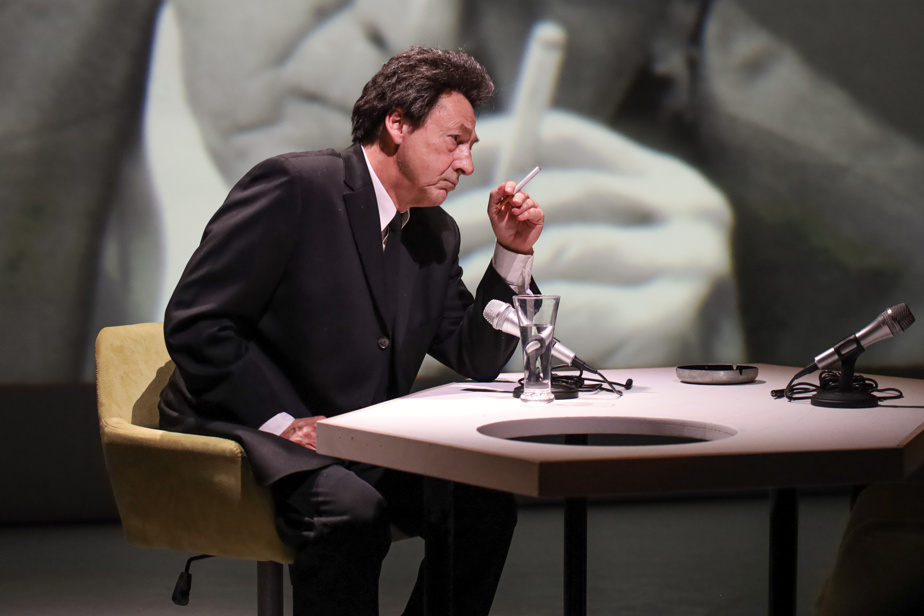One was an indomitable and fiery painter. The other is a director of formidable creativity. The life of Jean Paul Riopelle brought to the Duceppe stage by Robert Lepage has been a dream since the announcement of the project. But despite a few moments of grace, the meeting between the two giants did not cause the expected shock.
With his piece Le projet Riopelle, the high point of the celebrations surrounding the painter’s 100th birthday, Robert Lepage had given himself the delicate mission of lifting the veil on an artist shrouded in an aura of mystery. The man spoke little about himself and did not speak more about the motivations behind his art.
What we do know, however, is that Riopelle was at the heart of the Automatistes movement, which culminated in the publication of the Refus global manifesto. His tumultuous 25-year affair with American painter Joan Mitchell has also been widely documented. His friendships, his meetings in the Paris of the 1950s with André Breton, Giacometti, Beckett too. It is on this very concrete material that Lepage decided to rely to create his colossal fresco.
In doing so, the director (who also signs the scenography and the text, in collaboration with Olivier Kemeid) remains very wise in his scenic metaphors.
Here, everything is brutally chronological, geographically identifiable and identified. The result is a studious and undoubtedly fair biography, down to the smallest commas, but rather scholarly. Without a few touches of poetry, life — even that of the greatest among us — remains a series of facts. The result can be abundant, of course, but the emotion struggles more to make its way to the heart of the spectator.
The piece, we will remember, was commissioned by the Jean Paul Riopelle Foundation. And the estate of the painter had a watchful eye on the final product, to the point of attending, a rare thing, certain repetitions. This perhaps explains a certain reluctance of Robert Lepage to take off from the facts to enter the less tangible inner world of Riopelle. In fact, we are more attached to the character of Joan Mitchell who, unlike that of the Quebec painter, is presented in all her humanity.
Fortunately, the shivers win us at times in this show which extends over nearly four hours.
The reading of Refus global by the character of Paul-Émile Borduas raised spontaneous applause on the evening of the premiere. Ditto for the magnificent scene where Riopelle flies over the ice of the Far North, ice that is transformed, by a magic of which only Lepage is capable, into giant canvases, those of the Quatuor en blanc — Soleil de midnight, painted by Riopelle in 1977.
In the role of Riopelle at middle age, Luc Picard is very convincing, despite some wavering in the Quebec accent and the rolls of his character. Anne-Marie Cadieux embodies a Joan Mitchell always on the verge of imploding, with all the talent that we know of her. The performances of Noémie O’Farrell, Gabriel Lemire, Violette Chauveau and Étienne Lou (overwhelming in the role of Claude Gauvreau) are also noteworthy.
Moreover, the ten performers embody in The Riopelle Project more than a hundred roles! It takes breath and the performers never run out of it. Hat !
The scenography, the cornerstone of Lepage’s work, is of great beauty and undeniable ingenuity. In this regard, the projections are breathtaking, transforming the white backdrop into a thousand mirages.
But, as is often the case with plays by the Quebec director, everything was not yet settled on the evening of the premiere. The plethora of stage technicians responsible for taking us from Montreal to Paris and from Île-aux-Oies to the Vanves workshop had their hands full. It also happened that setting up a set took longer than the entire scene that took place there.
These laborious changes of scenery will be more fluid over the performances, no fear about it. But it remains that certain decisions, such as moving heavy pieces of wood throughout the third table, break the rhythm.
Robert Lepage needs public reactions to refine his productions. He knows how to take advantage of this exchange between the room and the stage to straighten out what needs to be straightened out. No doubt the piece will improve as it matures. But on the evening of the premiere, a few stones were missing from the building so that our expectations – immense, we admit – would be met.
